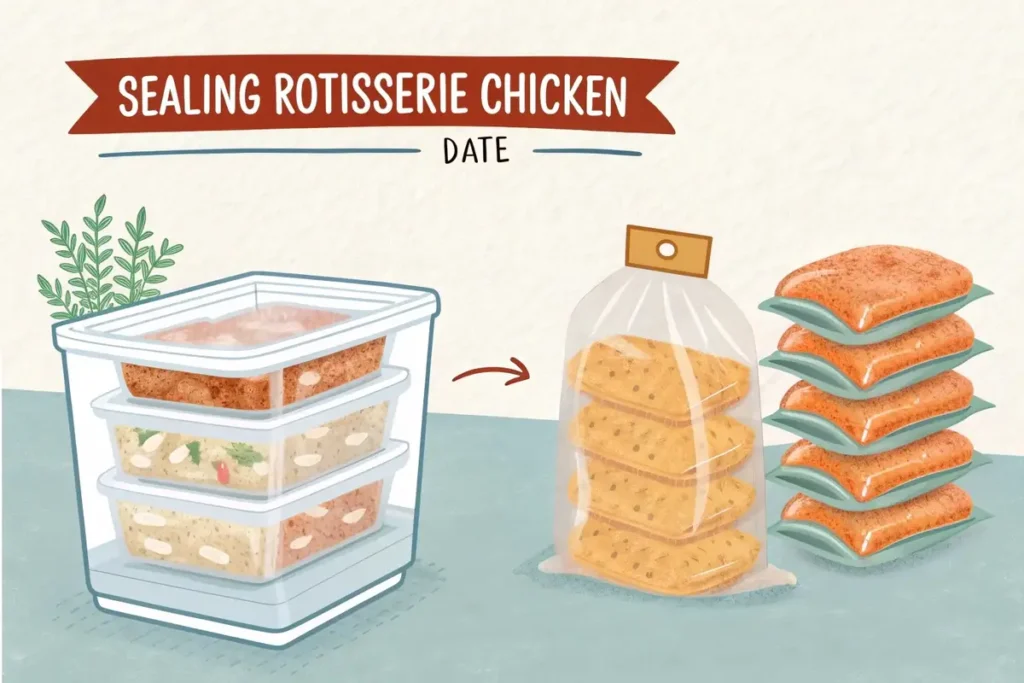Introduction
Leftover rotisserie chicken often becomes a time-saving hero in the kitchen. But can you freeze rotisserie chicken after 3 days to extend its life? Absolutely! This article delves into safe storage practices, freezing techniques, and reheating tips to help you preserve flavor, reduce waste, and whip up convenient meals effortlessly.
Understanding the Safe Timeline for Freezing Rotisserie Chicken
Rotisserie chicken is a versatile meal staple, but storing it correctly is critical. Let’s explore how long it remains safe and why timing matters.
How Long Can Rotisserie Chicken Stay Fresh?
Rotisserie chicken remains fresh in the refrigerator for 3 to 4 days if stored at a consistent temperature of 40°F or below. This timeframe ensures safety and optimal flavor while preventing harmful bacterial growth.
Why Timing Matters Before Freezing
Freezing chicken earlier within the 3–4 day window preserves its moisture and texture. Waiting too long might result in dry, unappetizing meat even after reheating. Always aim to freeze chicken when it’s still fresh to maximize taste.
When Should You Avoid Freezing Chicken?
If your chicken has been sitting in the fridge for more than four days or shows signs of spoilage, such as a slimy texture or sour smell, it’s best to discard it. Freezing will not reverse spoilage or restore quality.
Understanding Shelf Life of Rotisserie Chicken
How Long Does Rotisserie Chicken Last in the Fridge?
Rotisserie chicken, when properly stored, can last up to 3–4 days in the fridge. For maximum safety, always refrigerate the chicken within two hours of purchase. Packaging matters too—airtight containers or resealable bags help prevent air exposure, which can accelerate spoilage. A consistent refrigeration temperature of 40°F or below is essential for maintaining freshness.
Signs Your Rotisserie Chicken Is Still Safe to Freeze
Before freezing leftover chicken, perform a quick visual and smell test. Fresh chicken should have a neutral, appetizing aroma and retain its natural color without any gray or green patches. Avoid freezing if the chicken feels slimy or emits a sour smell—these are telltale signs of spoilage.
Why Freezing is an Effective Storage Solution
Freezing is a highly effective way to preserve chicken quality and extend its usability. By slowing bacterial growth and halting spoilage, freezing keeps your chicken safe for up to three months. Moreover, it locks in moisture and flavor, especially when done promptly after cooking or within the initial refrigeration period.
Preparing Rotisserie Chicken for Freezing
Steps to Prepare Rotisserie Chicken for Freezing
Portioning the Chicken
Begin by shredding or cutting the chicken into meal-sized portions. Smaller portions freeze more efficiently and defrost quicker, making them convenient for future recipes like soups, salads, or casseroles. Separate dark and white meat for added versatility in cooking.
Using Airtight Containers or Freezer Bags
Prevent freezer burn by storing chicken in airtight containers or heavy-duty freezer bags. Squeeze out as much air as possible before sealing. If using containers, choose those made of freezer-safe materials to maintain the chicken’s quality.
Labeling for Easy Tracking
Always label your storage containers or bags with the date and portion details. This ensures you use older portions first and prevents wastage. Proper labeling also helps track the chicken’s freshness during its freezer lifespan.

Best Practices for Retaining Flavor and Texture
- Wrap It Right: Wrap each portion tightly in plastic wrap or aluminum foil before placing it in a freezer bag. This extra layer adds protection against moisture loss.
- Double Bagging: For added security, place the sealed bag inside another freezer bag to minimize exposure to air and prevent freezer burn.
How to Safely Freeze Rotisserie Chicken After 3 Days
When to Freeze Rotisserie Chicken
Freezing rotisserie chicken can be done at different stages, but timing matters. Freezing immediately after purchaseensures maximum freshness, locking in flavor and texture. However, if the chicken has been refrigerated for up to three days, it’s still safe to freeze—just ensure it hasn’t shown signs of spoilage.
Delayed freezing raises concerns about bacterial growth, but proper refrigeration (below 40°F) significantly reduces risks. It’s important to freeze the chicken before it reaches the four-day mark in the fridge to maintain safety and quality.
Techniques for Freezing
Freezing Whole Chicken vs. Shredded Pieces
Whole rotisserie chicken is suitable for freezing, but shredding or portioning offers distinct advantages. Smaller portions are easier to store and defrost, saving time when preparing meals. Additionally, shredded chicken freezes more evenly, reducing the risk of freezer burn. Divide the chicken into dark and white meat for more flexibility in future recipes.
Using a Vacuum Sealer for Long-Term Storage
For optimal long-term storage, consider using a vacuum sealer. This method removes air from the packaging, which prevents freezer burn and maintains flavor. If you don’t have a vacuum sealer, manually remove as much air as possible from freezer bags by pressing down before sealing. Double-bagging also helps protect the chicken from moisture loss.
Thawing and Reheating Frozen Rotisserie Chicken
Safe Methods for Thawing Frozen Chicken
Refrigerator Thawing
The safest way to thaw frozen rotisserie chicken is in the refrigerator. Simply transfer the chicken from the freezer to the fridge and allow it to thaw overnight. This method ensures the chicken stays at a safe temperature throughout the process, reducing the risk of bacterial growth.
Quick Thawing Techniques
If time is limited, quick-thawing methods can be used:
- Microwave: Use the defrost setting to thaw chicken quickly. Make sure to rotate or flip the chicken to ensure even thawing.
- Cold Water Bath: Submerge the chicken in a sealed bag in cold water, changing the water every 30 minutes. This method is faster than refrigeration but still safe if monitored closely.
Reheating Tips for Preserving Quality
When reheating thawed chicken, it’s crucial to maintain moisture and avoid drying it out. Add a small amount of broth, water, or sauce before reheating to keep the meat juicy.
- Oven Reheating: Cover the chicken with foil and heat at 350°F until the internal temperature reaches 165°F.
- Microwave Reheating: Use a microwave-safe container and cover with a damp paper towel to retain moisture. Reheat in short intervals, stirring or flipping as needed.
By following these steps, your frozen rotisserie chicken can taste just as good as when it was fresh.

Common Mistakes to Avoid When Freezing Rotisserie Chicken
Mistakes That Compromise Chicken Quality
Freezing Chicken with Bones vs. Without Bones
While freezing chicken with bones is possible, removing the bones can significantly improve storage efficiency and make reheating easier. Bone-in chicken may also take longer to defrost and can retain less moisture during freezing. If you prefer freezing the whole chicken, ensure it’s tightly wrapped to minimize air exposure.
Neglecting to Remove Excess Moisture Before Freezing
Excess moisture on the chicken can lead to ice crystals forming during freezing, which impacts texture and flavor. To prevent this, pat the chicken dry with paper towels before packing it for the freezer. Properly sealed packaging, such as vacuum-sealed bags or tightly wrapped freezer-safe containers, also helps prevent ice buildup.
Storage Duration Limits
Why Consuming Frozen Chicken Within 3 Months is Recommended
While frozen chicken can technically remain safe to eat beyond three months, its flavor and texture may deteriorate over time. Prolonged storage increases the risk of freezer burn, which dries out the meat and affects its quality.
Risks of Extended Freezer Storage
Keeping chicken frozen for extended periods (e.g., over six months) can lead to a noticeable decline in taste and texture. Always label the chicken with the freezing date and aim to consume it within the recommended three-month window for optimal quality.
Frequently Asked Questions (FAQs)
Is freezing rotisserie chicken safe after 3 days in the fridge?
Yes, it is safe to freeze rotisserie chicken after three days in the refrigerator, provided it has been stored properly. Ensure the chicken shows no signs of spoilage before freezing it.
Can I freeze chicken that has been reheated before?
While it’s possible to freeze reheated chicken, it’s best to freeze it immediately after initial cooking to maintain quality. Reheating and refreezing multiple times can lead to texture changes and reduced flavor.
How do I prevent freezer burn on rotisserie chicken?
To prevent freezer burn, use airtight containers or freezer bags. Remove as much air as possible before sealing. Double-bagging or wrapping the chicken in foil before placing it in a freezer bag provides extra protection.
What’s the best way to thaw frozen chicken quickly?
The quickest safe method for thawing is to submerge the chicken, sealed in a leak-proof bag, in cold water. Change the water every 30 minutes. Alternatively, use the microwave’s defrost setting for faster results.
Does freezing chicken affect its nutritional value?
Freezing has minimal impact on the nutritional value of rotisserie chicken. Protein, vitamins, and minerals remain intact. However, texture and moisture may slightly change depending on how it’s frozen and thawed.
Creative Ways to Use Frozen Rotisserie Chicken
Easy Meal Ideas with Frozen Chicken
Frozen rotisserie chicken is a lifesaver when you’re short on time. For a quick and hearty meal, use shredded chicken in soups like chicken noodle soup or chicken tortilla soup. Casseroles, such as chicken and broccoli bake or cheesy chicken and rice, are another great option, turning leftovers into a family-friendly dish.
If you prefer something faster, toss the chicken into a stir-fry with your favorite vegetables and sauce for a flavorful and balanced dinner. For a lighter meal, use thawed chicken in wraps, tacos, or grain bowls loaded with fresh ingredients.
Adding Flavor to Reheated Chicken
Reheated chicken can sometimes lose its zest, but sauces and spices can revive its taste. Toss the chicken in a barbecue or buffalo sauce to create sandwiches, or use a creamy alfredo sauce for pasta dishes. Experiment with spice blends like Cajun, taco seasoning, or Italian herbs to match your recipe.
To restore moisture and enhance flavor, simmer chicken in broth before adding it to recipes. This simple trick helps avoid dryness and keeps the chicken juicy and delicious.
Conclusion
Making the Most of Your Rotisserie Chicken
Freezing rotisserie chicken after three days is a practical way to extend its shelf life while ensuring it remains safe and flavorful. By following proper freezing, thawing, and reheating practices, you can enjoy your leftovers without compromising quality.
Whether you transform frozen chicken into a hearty soup or a quick stir-fry, the possibilities are endless. Creative recipes and proper storage techniques reduce food waste and help you make the most of your purchase. So, next time you’re wondering what to do with leftovers, remember that frozen rotisserie chicken is a versatile and time-saving ingredient.

